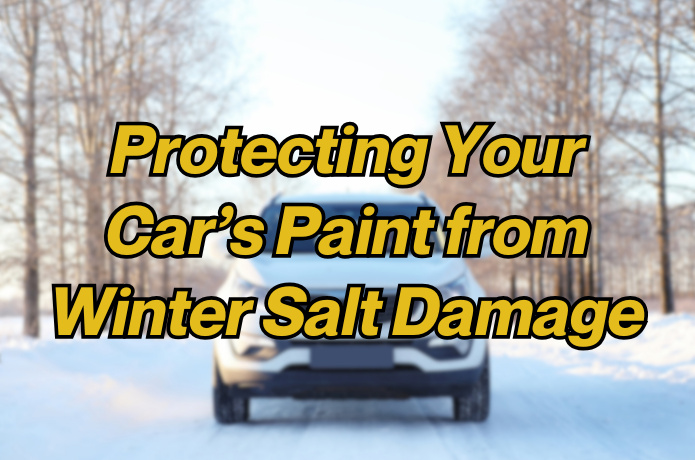Protecting Your Car’s Paint from Winter Salt Damage
Protecting Your Car’s Paint from Winter Salt Damage

As winter approaches, the use of road salt to keep streets safe becomes more common. While road salt is effective at preventing ice buildup, it can be harmful to your car's paint. The salt is corrosive, and when it mixes with water, it creates a solution that can eat away at the paint and cause long-term damage to the vehicle’s exterior. Without proper protection, this salt damage can lead to rust, fading, and even the deterioration of metal parts on your car.
To keep your car in good condition during the winter, it's important to take steps to protect it from winter salt damage. By understanding how salt affects the car’s paint and knowing how to clean and protect the surface, you can keep your car looking fresh and prevent costly repairs. This article offers tips on how to protect your car's paint from winter salt damage and keep your vehicle in the best possible shape during the harsh winter months.
1. Wash Your Car Frequently
The most important step in protecting your car from winter salt damage is to wash it regularly. Salt from the road can build up on your car's surface and cause serious damage over time. If left on the vehicle for too long, salt can begin to corrode the paint, leading to rust and chips. The key is to wash your car frequently during winter, especially after driving on salty roads.
Use a high-pressure hose to remove as much salt as possible from the surface of your car. Pay extra attention to areas that are more prone to salt buildup, such as the wheel wells, undercarriage, and lower parts of the doors. In addition, cleaning the car regularly helps to remove any grime, dirt, and moisture that might be trapped along with the salt, which can further speed up the damage. Frequent washes ensure that salt doesn’t have a chance to sit on your vehicle and cause long-lasting harm.
2. Use a Quality Car Wash Soap
When washing your car, it’s important to use a car wash soap that is specifically designed for the job. Some soaps contain harsh chemicals that can strip away protective wax and even damage the paint. Instead, look for a gentle, pH-balanced car wash soap that will effectively clean the surface without harming the paint. A good-quality soap will help remove salt and grime while preserving the paint’s finish.
Avoid using household cleaning products like dish soap or laundry detergent, as these can dry out and damage the car’s paint over time. It’s always better to invest in a proper car wash soap that is made for use on automotive paint. This simple step will protect your car’s exterior and help keep it looking good through the winter months.
3. Apply a Wax Coat Before Winter
One of the best ways to protect your car from salt damage is to apply a layer of wax before the winter season begins. Wax acts as a barrier between your car's paint and the elements, including road salt. A fresh coat of wax can help seal the paint and prevent salt from directly contacting the surface, making it much easier to wash off later.
Applying wax creates a protective layer that resists dirt, grime, and salt, and it also adds a glossy finish to the vehicle. You can either apply wax by hand or use a machine for an even coat. Make sure to choose a high-quality car wax that is designed for winter protection. It’s best to apply wax before the first snow and reapply it every few months throughout the winter season for continued protection.
4. Consider a Paint Protection Film
For extra protection, you may want to consider installing a paint protection film (PPF) on your vehicle. A paint protection film is a transparent, durable film that adheres to your car’s paint and offers an extra layer of defense against road salt, rocks, and other debris. This protective film can prevent salt from directly touching the car's paint, reducing the risk of rust, chips, and other forms of damage.
While paint protection film can be more expensive than other methods, it’s an excellent option for those who want long-term protection against winter salt damage. The film is also self-healing, meaning it can recover from minor scratches or scuffs. Paint protection film is a great investment for anyone looking to maintain their car’s appearance through the harsh winter months.
5. Use Underbody Protection
The undercarriage of your car is particularly vulnerable to winter salt damage. Salt can build up underneath the vehicle and cause corrosion, leading to rust on important parts like the frame and suspension. To prevent this, consider using an underbody protection spray. These sprays are designed to coat the underside of your car and protect it from salt, water, and other harsh winter conditions.
Underbody protection is easy to apply and can help prevent long-term damage to your car’s undercarriage. It creates a barrier that keeps moisture and salt from reaching the metal surfaces underneath the vehicle. This step is especially important for cars that are frequently driven on salted roads during the winter. Underbody protection ensures that your car stays rust-free and operates smoothly for many years.
6. Avoid Parking on Salted Roads
Whenever possible, try to avoid parking your car on roads that have been salted. Salt can continue to affect your car’s paint even when the vehicle is parked. If you must park on a salted road, consider moving your car into a garage or sheltered area after driving to limit its exposure to salt. A heated garage is the ideal place to park your vehicle, as the warmth will help dry any moisture that may have accumulated on the surface and prevent salt from settling on the paint.
Parking off salted roads also limits the amount of salt that comes into contact with your car’s undercarriage. If a garage or sheltered area is not available, consider using a car cover for added protection against winter salt damage. A well-fitted car cover will protect your car from salt, snow, and ice while it’s parked outside.
7. Touch Up Paint Chips Immediately
If you notice any chips or scratches on your car’s paint, take the time to touch them up as soon as possible. Even small chips can expose the underlying metal to salt, which can lead to rust formation. Many auto supply stores offer touch-up paint that matches the color of your car. Apply the paint carefully to the affected areas, and make sure the surface is clean and dry before doing so.
Touching up paint chips not only helps protect your car from rust but also keeps the overall appearance of your vehicle looking its best. By taking care of small issues immediately, you can prevent larger problems from developing down the road.
Winter road salt is a major threat to your car’s paint, but by following a few simple steps, you can protect your vehicle from its harmful effects. Regular washing, using quality car wash soap, applying wax, and installing paint protection film are all effective ways to guard your car’s exterior against salt damage. Additionally, underbody protection, parking in a sheltered area, and touching up paint chips quickly can prevent corrosion and rust. By taking these measures, you can keep your car looking great and maintain its value through the winter months.

